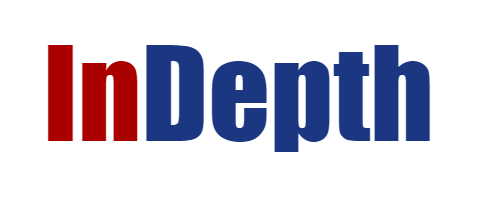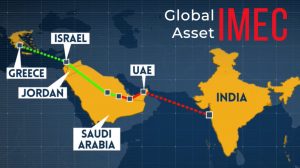Redrawing the Middle East: Strategic Fault Lines Between IMEC and INSTC
A Critical Analysis of U.S. Democratic Hesitation, Iranian Disruption, Turkish Expansionism, and Qatari Opportunism
By Sherzad MamSani
(EastMed SSI contributor) Head of the Israel-Kurdistan Alliance Network
The Middle East of 2025 stands at a historic crossroads. With the fall of the Assad regime and the emergence of a fragile transitional authority in Damascus, the end of the Gaza war, and the accelerating competition between the India–Middle East–Europe Economic Corridor (IMEC) and the International North‑South Transport Corridor (INSTC), the region is being reshaped. Republicans and their regional allies — Israel, India, and the Gulf states — seek stabilization through strategic integration; this is hindered by the disruptive ambitions of Iran, Turkey, and Qatar, and by U.S. Democratic hesitation.
Damascus in Transition: A Playground for Regional Powers
The collapse of Assad’s regime and the rise of Ahmed al‑Sharaa’s transitional government has not brought Syria closer to stability. Damascus is a bargaining table for competing agendas: Turkish red lines against Kurdish autonomy; Iranian militia‑economic entrenchment; Qatari soft‑power funding; and a Democratic posture that leaves Kurdish allies exposed.
Gaza’s Day After: The Illusion of Reconstruction
Qatar presents itself as Gaza’s savior while sustaining Islamist influence; Turkey promotes Brotherhood‑aligned actors; Israel maintains security dominance; Democratic reluctance to confront Qatari manipulation risks turning Gaza into an Islamist protectorate.
IMEC vs INSTC: Competing Corridors, Competing Futures
IMEC links India to Europe via Israel and the Gulf; INSTC connects India to Russia and Northern Europe via Iran. Republicans see IMEC as a linchpin; Democrats’ delay yields space for the Iran‑Russia axis via INSTC; Qatar and Turkey exploit instability to obstruct IMEC.
Turkey’s Neo‑Ottoman Ambitions
Ankara weaponizes the Kurdish question: cross‑border strikes on SDF; so‑called ‘safe zones’; demographic engineering — often enabled by U.S. hesitation.
Iran’s Shadow Networks
Iran embeds militias across Iraq, Syria, Lebanon, and Yemen; leverages INSTC to bypass sanctions; threatens maritime lanes and IMEC’s viability.
Strategic Maps
A digital map infographic on a dark gray backgroun.png (inserted)
A page from a thesis by SHERZAD MAMSANI features a.png (inserted)
Analytical Addendum: User Thesis & Evidence Check
The author advances a thesis: Democratic administrations tried to reconfigure Sykes–Picot for a ‘new Middle East’; the Arab Spring and ISIS emerged within that context with help from Turkey, Iran, and Qatar; Republican victories reversed course (killing Baghdadi and Soleimani) and enabled a new map favoring Israel, Kurds, Saudis, the UAE, and Jordan; the 2017 Kirkuk crisis was an Iranian‑backed retaliation for the Kurdish referendum; and IMEC plus a revived Kirkuk–Haifa pipeline could anchor the new order. Below is a claim‑evidence matrix reflecting a critical but documented view.
Key Claims vs. Public Evidence (2010–2025)
- Claim: Hayden/Le Figaro (2015): ‘Iraq no longer exists; Syria neither.’
Evidence: Documented interview; description of state collapse, not a blueprint for U.S. redrawing. - Claim: Democrats engineered a Sykes–Picot redesign via the Arab Spring.
Evidence: Interpretive. Public sources show support for some uprisings/opposition, but no primary document confirms a U.S. plan to alter borders. - Claim: ISIS was created by Democrats with help from Turkey, Iran, Qatar.
Evidence: Unsupported as causation. Origins trace to Zarqawi’s network after 2003; U.S. led the anti‑ISIS coalition; Iran‑aligned militias fought ISIS; allegations persist over Turkish border laxity and Qatari‑based private fundraising that U.S. Treasury targeted. - Claim: Republicans killed ISIS’s caliph and struck the IRGC‑QF chief.
Evidence: Documented: Baghdadi killed Oct 2019 (Operation Kayla Mueller); Qassem Soleimani killed Jan 2020 by U.S. strike. - Claim: Assad fell; Ahmed al‑Sharaa leads a transitional authority (2025).
Evidence: Documented in 2024–2025 coverage/analyses, though contested. - Claim: Kirkuk crisis (Oct 2017) retaliated for the referendum with Iran‑backed militias involved.
Evidence: Documented: Iraqi federal forces retook Kirkuk after the referendum; PMF roles widely reported. - Claim: Kirkuk–Haifa pipeline built in 1921 and poised for reopening.
Evidence: Correction: Built 1932–34; operated from 1935; closed after 1948. Reopening remains hypothetical.
Corrected Historical Note: Kirkuk–Haifa Pipeline
Constructed by the Iraq Petroleum Company (1932–34), the Kirkuk–Haifa pipeline split at Pump Station K‑3 near Haditha; a sister line ran to Tripoli, Lebanon. The pipeline ceased operations after 1948. Any modern revival would require new treaties, financing, and security guarantees.
Endnotes & Sources
– Le Figaro (Laure Mandeville), 6 Jul 2015 — Interview with Gen. Michael Hayden.
– UK House of Commons Library (CBP‑10161), 23 Jul 2025 — Syria after Assad; interim governance under Ahmed al‑Sharaa.
– FDD, 12 Aug 2025 — ‘Assad Is Gone. The Syrian Problem Persists.’
– White House (Archive), 27 Oct 2019 — Remarks on the death of Abu Bakr al‑Baghdadi.
– DOJ redacted memo (2020) — Soleimani strike legal analysis.
– Reuters, 16 Oct 2017 — Iraqi forces seize Kirkuk from Kurds after the referendum.
– GEM & IPC archives — Kirkuk–Haifa pipeline built 1932–34; operations began 1935.
– U.S. Treasury, 4 Mar 2014 — Remarks on Syria funding networks including Gulf‑based fundraisers.
– The Guardian, 14 Jun 2014 — Iran sends troops into Iraq to aid fight against ISIS.
– TIME (2016) — On the origins of ISIS (Zarqawi → Baghdadi).
– Reuters, 27 Aug 2025 — Bahrain resumes Israeli ties (Abraham Accords endurance).

